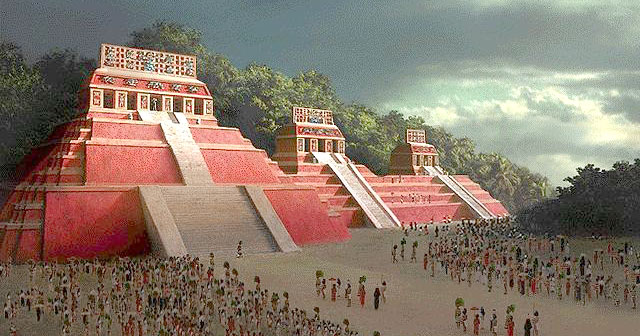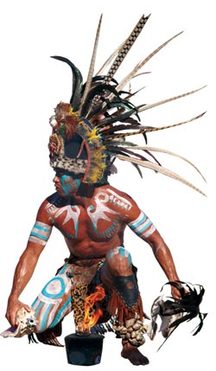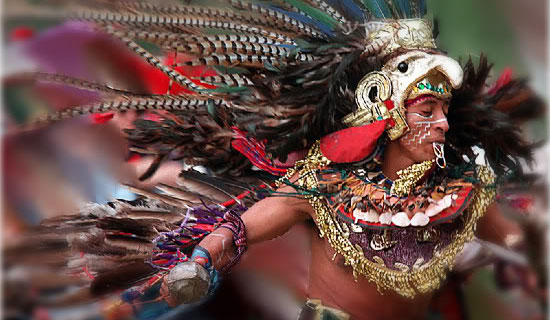Maya Religion
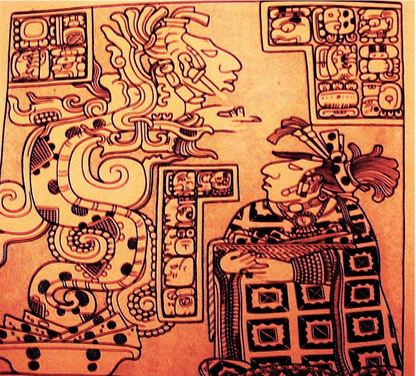
Essential Themes
Beliefs: Why do people live the way they do?
Culture: How do we know what we know about human history?
Beliefs: Why do people live the way they do?
Culture: How do we know what we know about human history?
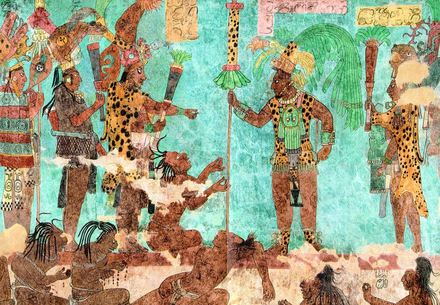 Bloodletting, shown above in a Maya mural, was just one way the Maya people included religion in their daily lives.
Bloodletting, shown above in a Maya mural, was just one way the Maya people included religion in their daily lives.
What role did religion play in the daily life of the Maya?
MAYA RELIGION
Religion was at the center of Maya culture and life and, like much of what we know about the Maya, it is complex, often confusing, and filled with mystery.
What is animism?
The Maya were polytheistic. That means that they believed in many gods. Maya gods were greatly the gods of nature, including the gods of the sun and of Venus and the Maize god (maize, or corn, was their most important crop). Their religious practices included festivals and rituals to honor their gods. Such festivals were led by priests who held an especially important place in Maya society. Maya priests had a hand in controlling nearly everything in Maya daily life. They decided when to plant crops, when to marry, and whom to sacrifice.
MAYA RELIGION
Religion was at the center of Maya culture and life and, like much of what we know about the Maya, it is complex, often confusing, and filled with mystery.
What is animism?
The Maya were polytheistic. That means that they believed in many gods. Maya gods were greatly the gods of nature, including the gods of the sun and of Venus and the Maize god (maize, or corn, was their most important crop). Their religious practices included festivals and rituals to honor their gods. Such festivals were led by priests who held an especially important place in Maya society. Maya priests had a hand in controlling nearly everything in Maya daily life. They decided when to plant crops, when to marry, and whom to sacrifice.
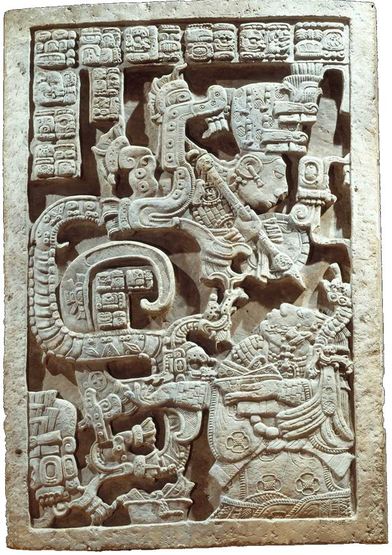
Maya religion, however, was about more than simply following the commands of their priests. The Maya viewed all of nature as sacred. They practiced a belief system called animism. Animism is the belief that objects, places and creatures all possess a distinct spiritual essence, or soul. For the Maya, all things - animals, plants, rocks, rivers, weather systems, human handiwork and perhaps even words - were alive.
From the multitude of spiritual forces alive in their world, every Maya had their own spiritual guide, a Wayob. In order to help a person through life, an individual's Wayob might appear to them as an animal or in a dream to offer guidance. In the carving to the left you see a figure emerging from the mouth of a "vision serpent."
THE MAYA WORLD
To the Maya, the world was flat. The Maya world, however, was anything but one-dimensional. The Maya believed that their flat world was watched over by four strong gods, one each at the corners representing the north, the south, the east and the west. Above the earth was heaven with its 13 layers. Each layer was represented by its own god.
Below was Xibalba, or the underworld. Xibalba was a cold, unhappy place that was divided into nine layers, each with its own Death Lord. When someone died of natural causes, their spirit went to the underworld where it had to work its way up through the layers to get to the supreme heaven. Women who died in childbirth and those who died as a sacrifice, as well as sacrificial victims of the ball game, Pok A Tok, however, got a quick ticket to go directly to the supreme heaven immediately after death.
From the multitude of spiritual forces alive in their world, every Maya had their own spiritual guide, a Wayob. In order to help a person through life, an individual's Wayob might appear to them as an animal or in a dream to offer guidance. In the carving to the left you see a figure emerging from the mouth of a "vision serpent."
THE MAYA WORLD
To the Maya, the world was flat. The Maya world, however, was anything but one-dimensional. The Maya believed that their flat world was watched over by four strong gods, one each at the corners representing the north, the south, the east and the west. Above the earth was heaven with its 13 layers. Each layer was represented by its own god.
Below was Xibalba, or the underworld. Xibalba was a cold, unhappy place that was divided into nine layers, each with its own Death Lord. When someone died of natural causes, their spirit went to the underworld where it had to work its way up through the layers to get to the supreme heaven. Women who died in childbirth and those who died as a sacrifice, as well as sacrificial victims of the ball game, Pok A Tok, however, got a quick ticket to go directly to the supreme heaven immediately after death.
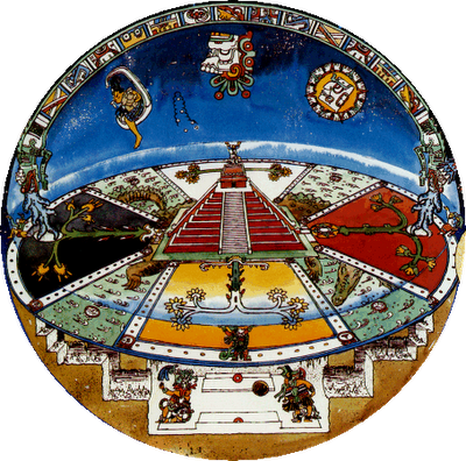 Maya religion detailed a clear view of the universe and how its many parts all fit together. In the picture below, note the gods of the moon and sun above, gods at each of the four corners and, interestingly, a ball court in the underworld.
Maya religion detailed a clear view of the universe and how its many parts all fit together. In the picture below, note the gods of the moon and sun above, gods at each of the four corners and, interestingly, a ball court in the underworld.
TREE OF LIFE
The Maya believed that a great and sacred tree connected the three levels. The roots of this “tree of life” stretched down into the underworld and its branches spread in the four directions of heaven above. The tree’s leafy canopy sheltered and protected the Maya and set the stars and heavenly bodies in motion. Both the souls of the dead and the gods could travel along the length of the tree and used this “road” to make their journeys between the levels of the universe.
Of course, the tree had symbolic meaning, as well. In the legend of the Hero Twins, when the father of the twins was killed by the lords of the underworld, his head was placed in the branches of a dead tree. When that happened, the tree sprang to life and bore a fruit which looked like the head of the twins’ dead father. The lords of the underworld became afraid of the tree’s power and forbade anyone from approaching it. When a daughter of one of the underworld lords approached the tree, however, she became pregnant. She then rose from the underworld to the world and gave birth to the Hero Twins. In the story and in Maya religion, the tree represents the never ending cycle of life
The Maya believed that a great and sacred tree connected the three levels. The roots of this “tree of life” stretched down into the underworld and its branches spread in the four directions of heaven above. The tree’s leafy canopy sheltered and protected the Maya and set the stars and heavenly bodies in motion. Both the souls of the dead and the gods could travel along the length of the tree and used this “road” to make their journeys between the levels of the universe.
Of course, the tree had symbolic meaning, as well. In the legend of the Hero Twins, when the father of the twins was killed by the lords of the underworld, his head was placed in the branches of a dead tree. When that happened, the tree sprang to life and bore a fruit which looked like the head of the twins’ dead father. The lords of the underworld became afraid of the tree’s power and forbade anyone from approaching it. When a daughter of one of the underworld lords approached the tree, however, she became pregnant. She then rose from the underworld to the world and gave birth to the Hero Twins. In the story and in Maya religion, the tree represents the never ending cycle of life
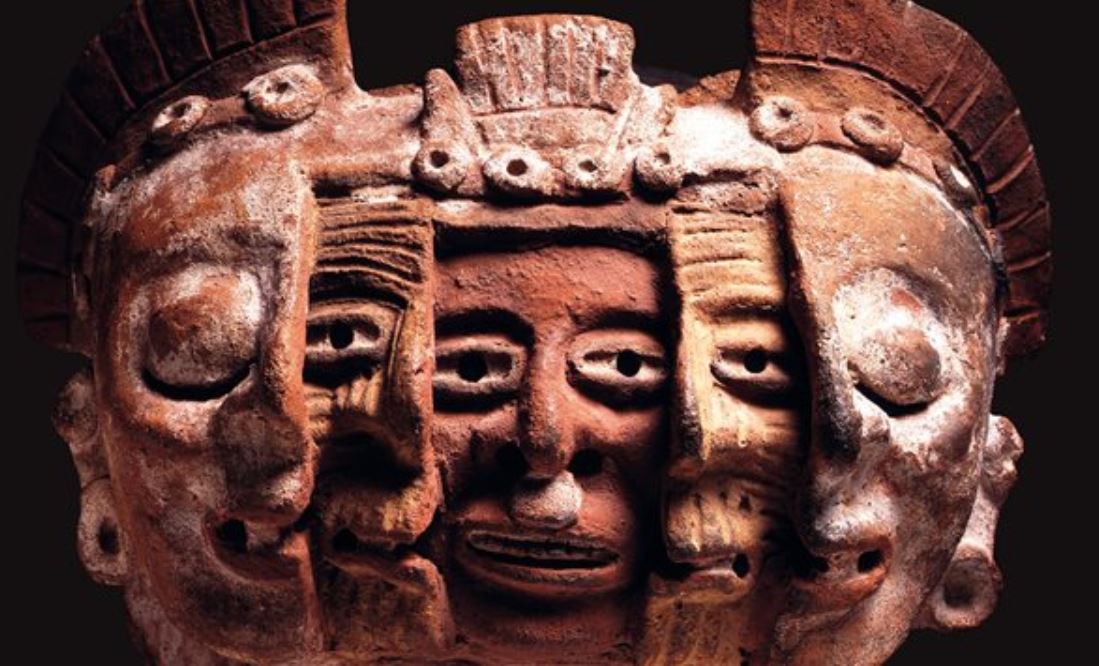
The Maya mask above shows the different stages of life as part of a never ending cycle of human evolution through life and the afterlife. The inner face represents the beginning of life at birth. The middle face is the most important one since it represents the adult stage when the person comes into his full potential and most of his life experiences happen. The outer face with eyes closed represents the end of earthly life.
BRAINBOX: Why do you think the Maya held festivals every 20 days?
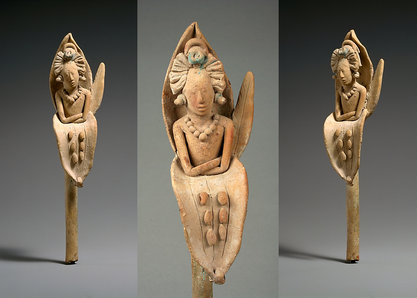 Above, a clay statue of a young corn god emerging from an ear of corn. It's hair represents the corn silk beneath the husk.
Above, a clay statue of a young corn god emerging from an ear of corn. It's hair represents the corn silk beneath the husk.
THE NATURE OF TIME
For the Maya, the idea of time was cyclical. Maya culture and beliefs reflected the cycles of creation and destruction, of seasons, of rituals and festivals, of life and death. Corn was so important to the Maya that the life-cycle of the corn plant is at the heart of their religion, as is the Corn God himself.
When a Maya died, it was believed they had moved on, not ended forever, to begin a new cycle of life.
Why did dancers wear masks during religious ceremonies?
For the Maya, the idea of time was cyclical. Maya culture and beliefs reflected the cycles of creation and destruction, of seasons, of rituals and festivals, of life and death. Corn was so important to the Maya that the life-cycle of the corn plant is at the heart of their religion, as is the Corn God himself.
When a Maya died, it was believed they had moved on, not ended forever, to begin a new cycle of life.
Why did dancers wear masks during religious ceremonies?
|
FESTIVALS
The most important activities in Maya cities were religious festivals. People who lived near a major city would travel to attend religious festivals and, of course, to watch the Maya ball games and to go to the market. There was a religious festival every 20 days. During festivals, priests dressed in fierce masks to please the gods and climbed the pyramid steps to perform rituals. Festivals were always filled with lots of drama and dancing. In the plays and dances that took place during Maya festivals, kings and other nobles were depicted as gods. During the festivities, Maya dancers performed in front of the pyramid or the temple or both. Like the festivals, Maya dancing followed a calendar. Dance performances included ones with humor and tricks, as well as some that simulated training for war. Still other dances mimicked, or even included sacrificial events and bloodletting. Complicated costumes were part of the dances. Masks, shells, feathers, headdresses, and body plates all helped to transform Maya dancers into historical figures, animals, and gods or other-worldly creatures. The Maya are especially famous for their headdresses. The movement of the dance would make their headdresses jingle and rattle. It was quite a sight. Some dances lasted all day, with food and drink brought to participants who kept dancing. |
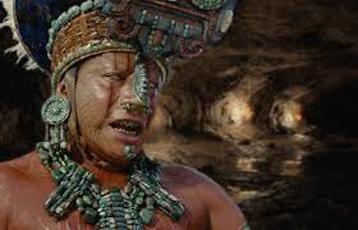 The Maya believed caves to be entrances to the Underworld. Here, a priest celebrates Ya'axche' in an underground cave.
The Maya believed caves to be entrances to the Underworld. Here, a priest celebrates Ya'axche' in an underground cave.
CEREMONIES AND RITUALS
Ceremonies and rituals of the Maya were performed on specific days of the year. As such, their rituals were closely related to the celestial and terrestrial. Priests used the Maya calendar to track and record the beginnings and end of these cycles.
K’atun: K’atun is a ceremony that was conducted every 20 years. It corresponds to a cycle on the Maya calendar. During K’atun, stelae were created to share what had happened for the past 20 years. The rulers were an important part of the story told through the stelae. A different royal family ruled each Maya city, so each Maya city erected its own stele to honor its ruling family.
Ya'axche': Ya’axche is another important celebration for the Maya. Because of its importance, only the most highly respected priests were allowed to conduct it. Ya’axche celebrates the sacred connection between heaven, earth, the Maya, and the underworld. Essentially, Ya’axche celebrates the animistic beliefs of the Maya and reconnects them to their environment. Because any place or object in nature might hold special sacred significance, this ceremony could be performed wherever a site was considered holy.
Ceremonies and rituals of the Maya were performed on specific days of the year. As such, their rituals were closely related to the celestial and terrestrial. Priests used the Maya calendar to track and record the beginnings and end of these cycles.
K’atun: K’atun is a ceremony that was conducted every 20 years. It corresponds to a cycle on the Maya calendar. During K’atun, stelae were created to share what had happened for the past 20 years. The rulers were an important part of the story told through the stelae. A different royal family ruled each Maya city, so each Maya city erected its own stele to honor its ruling family.
Ya'axche': Ya’axche is another important celebration for the Maya. Because of its importance, only the most highly respected priests were allowed to conduct it. Ya’axche celebrates the sacred connection between heaven, earth, the Maya, and the underworld. Essentially, Ya’axche celebrates the animistic beliefs of the Maya and reconnects them to their environment. Because any place or object in nature might hold special sacred significance, this ceremony could be performed wherever a site was considered holy.
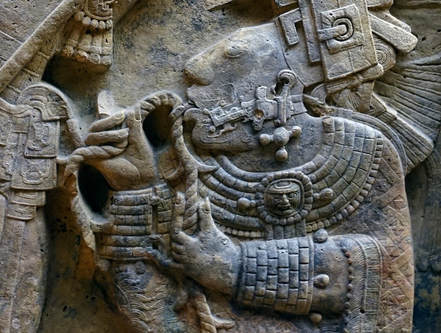 Bloodletting was a common Maya practice.
Bloodletting was a common Maya practice.
Why did the Maya prick themselves until they bled?
Sacrifice & Bloodletting: During the festivals, humans and animals were sometimes sacrificed to please the gods. The Mayans sacrificed iguanas, turtles, crocodiles, dogs, jaguars, and turkeys in large numbers. The supreme sacrifice, however, was that of human beings. The Maya believed that human blood was needed to sustain their gods. Sacrificial victims included enemy leaders and ball players, as well as criminals, slaves, women and children.
Not all sacrifices ended in death, however. Bloodletting was a much more common form of personal sacrifice. In bloodletting, people would use a stingray spine or sharp stone to prick or cut themselves. In the picture at left you see a Maya noblewoman pulling a cord with thorns through her tongue. When the king or nobles offered blood, a few drops were smeared on a bit of tree bark. The bark was then burned and the smoke floated to heaven where it could be consumed by the gods.
Sacrifice & Bloodletting: During the festivals, humans and animals were sometimes sacrificed to please the gods. The Mayans sacrificed iguanas, turtles, crocodiles, dogs, jaguars, and turkeys in large numbers. The supreme sacrifice, however, was that of human beings. The Maya believed that human blood was needed to sustain their gods. Sacrificial victims included enemy leaders and ball players, as well as criminals, slaves, women and children.
Not all sacrifices ended in death, however. Bloodletting was a much more common form of personal sacrifice. In bloodletting, people would use a stingray spine or sharp stone to prick or cut themselves. In the picture at left you see a Maya noblewoman pulling a cord with thorns through her tongue. When the king or nobles offered blood, a few drops were smeared on a bit of tree bark. The bark was then burned and the smoke floated to heaven where it could be consumed by the gods.
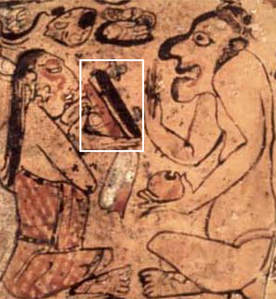
MIRRORS
One Maya legend says that if you looked at a mirror, you might be able to communicate with the demons who inhabited the Underworld. They believed that a mirror could act as a portal or doorway to the Underworld. Taken from a Maya vase, the picture to the right shows a man staring into a mirror (highlighted with the white box). Despite the danger, Maya boys sometimes looked into a mirror as a demonstration of their courage. Legend says that warriors going into battle wore mirrors on their backs. The idea was that if you tried to sneak up on a Maya warrior, a demon might reach out from the Underworld and snatch you.
THE AFTERLIFE
The Maya believed in an afterlife. Heaven was the home of the gods, and the Maya believed that a section of heaven was reserved for the Maya afterlife. That section of heaven is where the Maya believed their ancestors lived, always keeping a watchful eye on their relatives still alive on earth. Nobles were buried in tombs. Commoners buried their dead inside their homes, under the floor. That way, they could live with their ancestors and keep their ancestors easily posted on their daily life. The Maya believed in compensation after death. If they had a rough time or a rough life, this would be made up to them in their afterlife.
One Maya legend says that if you looked at a mirror, you might be able to communicate with the demons who inhabited the Underworld. They believed that a mirror could act as a portal or doorway to the Underworld. Taken from a Maya vase, the picture to the right shows a man staring into a mirror (highlighted with the white box). Despite the danger, Maya boys sometimes looked into a mirror as a demonstration of their courage. Legend says that warriors going into battle wore mirrors on their backs. The idea was that if you tried to sneak up on a Maya warrior, a demon might reach out from the Underworld and snatch you.
THE AFTERLIFE
The Maya believed in an afterlife. Heaven was the home of the gods, and the Maya believed that a section of heaven was reserved for the Maya afterlife. That section of heaven is where the Maya believed their ancestors lived, always keeping a watchful eye on their relatives still alive on earth. Nobles were buried in tombs. Commoners buried their dead inside their homes, under the floor. That way, they could live with their ancestors and keep their ancestors easily posted on their daily life. The Maya believed in compensation after death. If they had a rough time or a rough life, this would be made up to them in their afterlife.

